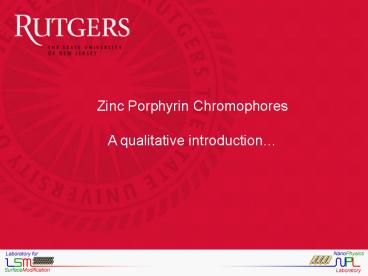Sub-Monolayer Sn/Cu(100) PowerPoint PPT Presentation
1 / 22
Title: Sub-Monolayer Sn/Cu(100)
1
Zinc Porphyrin Chromophores A qualitative
introduction
2
Porphyrin
3
Examples
Chlorophyll a
Heme group
Cytochrome c with heme c
4
Absorption properties
Typical UV-visible absorption spectrum
- S1 and S2 first and second excited states of the
molecule. - Fast internal conversion S2 ? S1
- B and Q bands both arise from p to p transitions
and can be explained by considering the four
frontier orbitals of the porphyrin.
5
Goutermann Four-Orbital Model
Orbitals
LUMOs
HOMOs
Energy states
Soret (B) band
S2
Q bands
S1
- Transitions between these orbitals gives rise to
two 1Eu excited states. - Orbital mixing splits these two states into a
high energy state with a high oscillator strength
and a low energy state with a low oscillator
strength.
S0
6
Zn-Porphyrin
2 HCl
2 ZnCl
Easy inclusion of the Zn2 ion in the cycle.
7
Zn-Porphyrin
Because the d orbitals of Zn are far enough in
energy from the p and p levels of the porphyrin,
the electronic structure of the Zn-Porphyrin is
close to the free Porphyrin.
8
Porphyrin as sensitizer
- TCPP exhibit a long-lived (gt1ns) p singlet
excited state and only a weak singlet/triplet
mixing. - Appropriate HOMO/LUMO levels position in energy.
- Functional groups have not much influence on the
TCPP electronic structure.
9
Zn-Porphyrin dyes
Tetrachelate Porphyrin Chromophores for Metal
Oxide Semiconductor Sensitization Effect of the
Spacer Length and Anchoring Group
Position Jonathan Rochford, Dorothy Chu, Anders
Hagfeldt, and Elena Galoppini JACS 129 (2007) 4655
10
Effect of the ending groups
Because the phenyl group is perpendicular to the
plane of the porphyrin, changing the ending group
does not strongly alter the porphyrin electronic
structure.
11
Effect of the ending groups
- Adsorbed on ZnO np, visible peak shifts.
- Only adsorption on a surface makes a difference
between the dyes.
Molecule bonding to the surface determines
electronic structure.
12
Effect of molecular orientation on the surface
Better results when the dye lies flat on the
surface, but not too far
13
Notes
At high coverage porphyrins have an inherent
tendency to aggregate, and dipole/dipole
interactions at high coverage are expected to
allow rapid migration of the excited state
between neighboring dyes, increasing the
probability of exciton annihilation.
The greater the degree of mixing, the less
intense the a band relative to the Soret band.
14
Effect of rigid linker length
E. Galoppini Unpublished ?
Longer linker, worst efficiency.
15
ZnO nanorods
Faster charge diffusion into the single crystal
nanorods.
16
Looks good What can we do?
17
Zn-Porphyrin
ZnP Zinc Porphyrin
ZnTPP Zinc TetraPhenylPorphyrin
ZnP and ZnTPP can be sublimated in UHV.
18
Zn-based dyes
These dye are believed to adsorb perpendicular to
the substrate and might form clusters of parallel
molecules.
19
Zn-based dyes
This dye is believed to adsorb flat on the
substrate.
20
Sample preparation
- Films stored in air, heated 150oC for 30 min,
then cooled to 80oC - Immersed in a 0.4 mM MeOH solution of dye for 1h
- Rinced with MeOH to remove physisorbed dye
21
Possible experiments
- XPS, UPS and IPS electronic structure of the
adsorbed dyes - Energy levels alignment
- Effect of polymerization on the electronic
structure?
- STM adsorption geometry of the dyes on TiO2 or
ZnO surfaces - STS?
22
12
Useful numbers

